 |

Timeline continued from
100 Years and Counting


1942
 Julia
Miller, a US Public Health Service consultant (second from left),
conducted a survey of Emory University and the Atlanta community
to determine the feasibility of a university school of nursing
at Emory. In 1943, she was named director of the school and nursing
service at Emory Hospital. Julia
Miller, a US Public Health Service consultant (second from left),
conducted a survey of Emory University and the Atlanta community
to determine the feasibility of a university school of nursing
at Emory. In 1943, she was named director of the school and nursing
service at Emory Hospital.
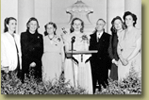


1943
 The
Emory Unit was reactivated during World War II. The unit included
nurses like Nina Rusk Carson, 35N, 51G, former dean of women at
Emory and a chief nurse in maxillofacial surgery at the time of
the war’s outbreak. Stationed in Northern Africa and then
Europe, the unit established one of the military’s first
ICUs in France. On the home front, Nell Hodgson Woodruff recruited
Red Cross volunteers for Emory University Hospital and worked
there herself to fill in for staff nurses serving in the military. The
Emory Unit was reactivated during World War II. The unit included
nurses like Nina Rusk Carson, 35N, 51G, former dean of women at
Emory and a chief nurse in maxillofacial surgery at the time of
the war’s outbreak. Stationed in Northern Africa and then
Europe, the unit established one of the military’s first
ICUs in France. On the home front, Nell Hodgson Woodruff recruited
Red Cross volunteers for Emory University Hospital and worked
there herself to fill in for staff nurses serving in the military.
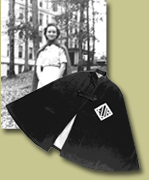


1944
 The
nursing school began to offer a baccalaureate-degree program and
was renamed Emory University School of Nursing, with Miller serving
as dean. The program required two years of arts and sciences education
for admission, followed by two years of professional nursing education.
Graduates received a bachelor of science in nursing (BSN) degree,
part of a national movement to elevate the professional requirements
and stature of nursing. The
nursing school began to offer a baccalaureate-degree program and
was renamed Emory University School of Nursing, with Miller serving
as dean. The program required two years of arts and sciences education
for admission, followed by two years of professional nursing education.
Graduates received a bachelor of science in nursing (BSN) degree,
part of a national movement to elevate the professional requirements
and stature of nursing.


1949
 Nell
Hodgson Woodruff presented the first Nell Hodgson Woodruff Award
to Mary Hall, 49N, 62MN, 83PhD, to honor an outstanding graduating
senior. (Hall later taught public health nursing at Emory and
served as interim dean.) Thus began the tradition of the Silver
Bowl Award, presented today by the Nurses Alumni Association to
a baccalaureate student and by the Associates to a graduate student
at graduation. Nell
Hodgson Woodruff presented the first Nell Hodgson Woodruff Award
to Mary Hall, 49N, 62MN, 83PhD, to honor an outstanding graduating
senior. (Hall later taught public health nursing at Emory and
served as interim dean.) Thus began the tradition of the Silver
Bowl Award, presented today by the Nurses Alumni Association to
a baccalaureate student and by the Associates to a graduate student
at graduation.
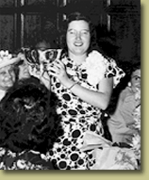


1951
 Ada
Fort became dean, serving until 1976. During her 25-year tenure,
Fort propelled the school forward in nursing practice, education,
and administration. In 1972, she founded a nonprofit organization
known today as Global Health Action, which trains health care
workers in more than 70 countries. Ada
Fort became dean, serving until 1976. During her 25-year tenure,
Fort propelled the school forward in nursing practice, education,
and administration. In 1972, she founded a nonprofit organization
known today as Global Health Action, which trains health care
workers in more than 70 countries.
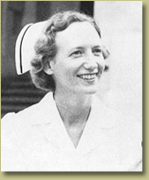 

1952
 The
last diploma class graduated. Concurrent with the baccalaureate
program, the School of Nursing continued to offer a diploma program
until 1949. The
last diploma class graduated. Concurrent with the baccalaureate
program, the School of Nursing continued to offer a diploma program
until 1949.


1953
 The
School of Nursing offices moved from Emory Hospital to the Bartholomew
Professional Building on Clifton Road, the present site of Children’s
Healthcare of Atlanta at Egleston. Classrooms remained The
School of Nursing offices moved from Emory Hospital to the Bartholomew
Professional Building on Clifton Road, the present site of Children’s
Healthcare of Atlanta at Egleston. Classrooms remained
in the hospital.


1954
 Supported
by grants from the Kellogg Foundation and the Commonwealth Fund,
the School of Nursing began a graduate program leading to the
master of nursing degree. It was the first such program in the
Southeast. Also, President Dwight D. Eisenhower (right) appointed
Nell Hodgson Woodruff (left) to the US delegation of the World
Health Organization. The appointment was a testament to Woodruff’s
leadership role in nursing. Years later, Dr. Marla Salmon held
this role in 1995 before becoming dean in 1999. Supported
by grants from the Kellogg Foundation and the Commonwealth Fund,
the School of Nursing began a graduate program leading to the
master of nursing degree. It was the first such program in the
Southeast. Also, President Dwight D. Eisenhower (right) appointed
Nell Hodgson Woodruff (left) to the US delegation of the World
Health Organization. The appointment was a testament to Woodruff’s
leadership role in nursing. Years later, Dr. Marla Salmon held
this role in 1995 before becoming dean in 1999.
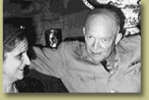


1957
 The
School of Nursing moved to “temporary” quarters in
Annex B (shown below) on the present site of the Goizueta Business
School. The nursing school remained there for The
School of Nursing moved to “temporary” quarters in
Annex B (shown below) on the present site of the Goizueta Business
School. The nursing school remained there for
13 years.
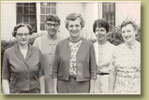


1959
 The
length of the BSN program was increased from two to three years,
making the total nursing program five years long. A visit by Mary
Clark Rockefeller led to the organization of the Associates, a
group of women dedicated to the promotion of the school. Among
the original group were Nell Hodgson Woodruff; her niece, Nell
Woodruff Hodgson Watt (“Little Nell”); and Mrs. Henry
Bowden, the first president. The
length of the BSN program was increased from two to three years,
making the total nursing program five years long. A visit by Mary
Clark Rockefeller led to the organization of the Associates, a
group of women dedicated to the promotion of the school. Among
the original group were Nell Hodgson Woodruff; her niece, Nell
Woodruff Hodgson Watt (“Little Nell”); and Mrs. Henry
Bowden, the first president.


1962
 Lt.
Keith Howard Taylor became the first male student admitted to
the graduate program. Lt.
Keith Howard Taylor became the first male student admitted to
the graduate program.


1963
 Verdelle
Bellamy (left) and Allie Saxon, both 63MN, entered the graduate
program as the first African American students in the school and
the first full-time African American students at the university.
Dean Ada Fort and Emory Board of Trustees Chair Henry Bowden fought
valiantly to admit both students. Verdelle
Bellamy (left) and Allie Saxon, both 63MN, entered the graduate
program as the first African American students in the school and
the first full-time African American students at the university.
Dean Ada Fort and Emory Board of Trustees Chair Henry Bowden fought
valiantly to admit both students.
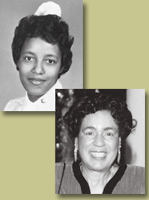


1964
 The
Alpha Epsilon Chapter of Sigma Theta Tau International, the nursing
honor society, was established. The
Alpha Epsilon Chapter of Sigma Theta Tau International, the nursing
honor society, was established.


1967
 Emory’s
Board of Trustees renamed the School of Nursing in honor of Nell
Hodgson Woodruff. Emory’s
Board of Trustees renamed the School of Nursing in honor of Nell
Hodgson Woodruff.


1968
 In
January, Woodruff attended the groundbreaking of the new School
of Nursing Building on Asbury Circle. She would not live to see
it completed, dying of a cerebral hemorrhage five days later.
Also that year, Francis Creegan enrolled as the first male BSN
student. In
January, Woodruff attended the groundbreaking of the new School
of Nursing Building on Asbury Circle. She would not live to see
it completed, dying of a cerebral hemorrhage five days later.
Also that year, Francis Creegan enrolled as the first male BSN
student.
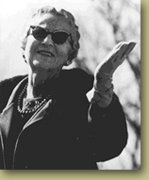


1970
 The
School of Nursing moved into its new building behind Emory Hospital.
The BSN curriculum was changed to an integrated format and shortened
to four academic years and one summer. Along with nursing courses,
students were enrolled in anatomy, physiology, The
School of Nursing moved into its new building behind Emory Hospital.
The BSN curriculum was changed to an integrated format and shortened
to four academic years and one summer. Along with nursing courses,
students were enrolled in anatomy, physiology,
biochemistry, microbiology, and pharmacology, taught by Emory
School of Medicine faculty.


1972
 Bob
Isom, the first African American male in the BSN program, graduated.
A year earlier, Mackie Norris became the first African American
woman on the faculty. Bob
Isom, the first African American male in the BSN program, graduated.
A year earlier, Mackie Norris became the first African American
woman on the faculty.


1976
 Dr.
Edna Grexton became dean of the School of Nursing, serving until
1984. Two years later, Dr. Clair Martin was appointed dean, serving
until 1992. Under their leadership, the school specialized in
nursing administration and education and the preparation of nurses
for increased hands-on patient care as clinical nurse specialists
and nurse practitioners. Dr.
Edna Grexton became dean of the School of Nursing, serving until
1984. Two years later, Dr. Clair Martin was appointed dean, serving
until 1992. Under their leadership, the school specialized in
nursing administration and education and the preparation of nurses
for increased hands-on patient care as clinical nurse specialists
and nurse practitioners.


1987
 The
school discontinued the use of navy blue uniforms for BSN students.
Also, the NEAT (Nursing Employment and Tuition) program was initiated
with Emory, Crawford Long, and other hospitals. Students defrayed
part of their tuition by working for one of the hospitals after
graduation. The
school discontinued the use of navy blue uniforms for BSN students.
Also, the NEAT (Nursing Employment and Tuition) program was initiated
with Emory, Crawford Long, and other hospitals. Students defrayed
part of their tuition by working for one of the hospitals after
graduation.
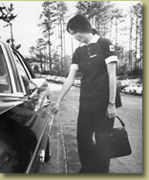


1990
 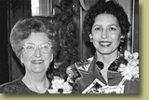
The Metropolitan Atlanta Community Foundation gave $1 million
to the nursing school to establish the Edith F. Honeycutt Chair
of Nursing. The chair was named for the 1939
alumna (top left) who was a pioneer in oncology nursing at Emory
and who served as a private nurse to the Woodruff family. Dr.
Deborah McGuire (top right), a researcher in cancer pain and symptom
management, became the first holder. Today, Drs. Jo Ann Dalton
and Kathy Parker hold Honeycutt Chairs. Also in 1990, the Independence
Foundation endowed a chair in nursing education. Dr. Ora Strickland
(bottomw) was its first holder. Dr. Maureen Kelley currently holds
an Indepen-dence Chair.
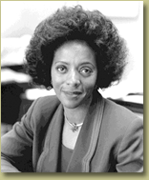 

1993
 Dr.
Dyanne Affonso was appointed dean, serving until 1998. During
her tenure, the university approved plans to construct a new nursing
school building and establish a doctoral program focused on nursing
research. Dr.
Dyanne Affonso was appointed dean, serving until 1998. During
her tenure, the university approved plans to construct a new nursing
school building and establish a doctoral program focused on nursing
research.
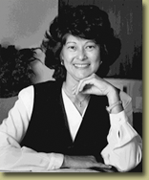


1999
 Dr.
Marla Salmon, former director of the Division of Nursing in the
US Department of Health, was appointed dean. Under her leadership,
enrollment has grown, research funding has increased, and the
school has broadened its efforts in service learning and international
nursing. Later in 1999, three students enrolled in the school’s
new doctoral program focused on clinical research. Dr.
Marla Salmon, former director of the Division of Nursing in the
US Department of Health, was appointed dean. Under her leadership,
enrollment has grown, research funding has increased, and the
school has broadened its efforts in service learning and international
nursing. Later in 1999, three students enrolled in the school’s
new doctoral program focused on clinical research.
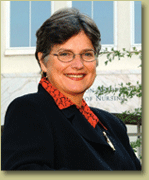


2000
 Dr.
Sandra Dunbar was appointed as the school’s Dr.
Sandra Dunbar was appointed as the school’s
first Charles Howard Candler Professor of Cardiovascular Nursing.
Distinguished faculty in different disciplines across the university
hold these endowed professorships.
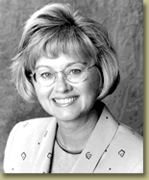


2001
 The
School of Nursing moved into a new state-of-the-art building,
which includes a teaching pavilion and clinical skills lab. The
building is strategically located on the Clifton Corridor between
the Rollins School of Public Health and the Centers for Disease
Control and Prevention. Also, the school established the Lillian
Carter Center for International Nursing to extend health care
to vulnerable people through more effective nursing leadership
and practice worldwide. Later that year, the school was awarded
federal funding to establish the Center for Research on Symptoms,
Symptom Interactions, and Health Outcomes. Directed by Dr. Kathy
Parker, the center is one of only nine exploratory centers in
the country funded by the National Institute of Nursing Research. The
School of Nursing moved into a new state-of-the-art building,
which includes a teaching pavilion and clinical skills lab. The
building is strategically located on the Clifton Corridor between
the Rollins School of Public Health and the Centers for Disease
Control and Prevention. Also, the school established the Lillian
Carter Center for International Nursing to extend health care
to vulnerable people through more effective nursing leadership
and practice worldwide. Later that year, the school was awarded
federal funding to establish the Center for Research on Symptoms,
Symptom Interactions, and Health Outcomes. Directed by Dr. Kathy
Parker, the center is one of only nine exploratory centers in
the country funded by the National Institute of Nursing Research.


2002
 The
School of Nursing received $5 million from The Helene Fuld Health
Trust, the largest gift in school history. The gift supports fellowships
for second-career students with an interest in serving vulnerable
populations. The fellowships are also intended to help fill the
critical shortage of nurses nationwide. The
School of Nursing received $5 million from The Helene Fuld Health
Trust, the largest gift in school history. The gift supports fellowships
for second-career students with an interest in serving vulnerable
populations. The fellowships are also intended to help fill the
critical shortage of nurses nationwide.


2003
 Dr.
Caroline Constantin became the first student to receive a PhD.
Also, US News & World Report ranked the school 26th overall
and 8th among private nursing schools in the nation. Dr.
Caroline Constantin became the first student to receive a PhD.
Also, US News & World Report ranked the school 26th overall
and 8th among private nursing schools in the nation.
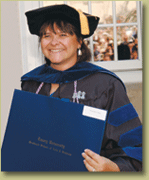


2004
 The
School of Nursing was ranked 18th among more than 600 nursing
schools and 6th among all private nursing schools for research
funding from the National Institutes of Health. Also, the school
began a dual-degree partnership with Agnes Scott College to attract
students with a strong liberal arts background and an interest
in nursing. The
School of Nursing was ranked 18th among more than 600 nursing
schools and 6th among all private nursing schools for research
funding from the National Institutes of Health. Also, the school
began a dual-degree partnership with Agnes Scott College to attract
students with a strong liberal arts background and an interest
in nursing.


2005
 The
School of Nursing launched a yearlong Centennial celebration.
To date, approximately 10,000 Emory-educated nurses have led the
way in patient care, public health, research, health education,
and health policy around the world. Also, Dr. Sarah Freeman became
the first holder The
School of Nursing launched a yearlong Centennial celebration.
To date, approximately 10,000 Emory-educated nurses have led the
way in patient care, public health, research, health education,
and health policy around the world. Also, Dr. Sarah Freeman became
the first holder
of the Betty Tigner Turner Professorship in Nursing.
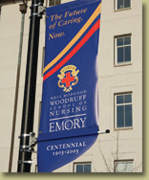
|
 |
 |
 homas
Carlyle, British historian and essayist from the Victorian era,
defined history in the most human of terms. “History is the
essence of innumerable biographies,” he wrote. His words ring
especially true for the individuals who have shaped the School of
Nursing during its first century. homas
Carlyle, British historian and essayist from the Victorian era,
defined history in the most human of terms. “History is the
essence of innumerable biographies,” he wrote. His words ring
especially true for the individuals who have shaped the School of
Nursing during its first century.
In conjunction with the nursing school’s
Centennial, retired nursing professor Rose Cannon is leading a project,
“Hearing Their Voices: Conversations with Retired Nell Hodgson
Woodruff School of Nursing Faculty.” Together, Cannon and
two other colleagues have gathered oral histories from 14 Emory
nursing leaders who have made a difference in the lives of their
students and the profession. Here are some of their stories.
Agent
of change
 hirley
Carey, hirley
Carey,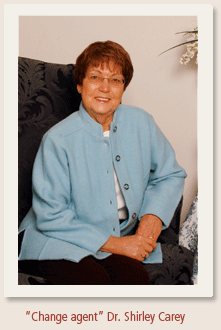 82PhD, is a child of the Depression. She learned early on the value
of hard work, adaptability, and grabbing onto opportunities. “We
were highly motivated,” says Carey, who retired in 1999 after
serving 27 years on the nursing faculty.
82PhD, is a child of the Depression. She learned early on the value
of hard work, adaptability, and grabbing onto opportunities. “We
were highly motivated,” says Carey, who retired in 1999 after
serving 27 years on the nursing faculty.
Since her first days in nursing, Carey
has been a change agent. At the Catholic hospital in Texas where
she first worked in laborand delivery, the “charity cases”
were down at the end of a long hallway, while the private patients
were closer to the nurses station. Carey organized a recovery room
for labor and delivery to improve care. “I cannot send these
women down to the far end of the wing,” she recalls saying.
“They’ll hemorrhage down there.”
Later, while working on her master’s
project at Children’s Hospital of Buffalo in New York, she
explored the problems of first-time mothers and multiparous women
(those with other children) who breast-fed their infants. She found
that first-time mothers experienced more severe role stress, anxiety,
and depression than multiparous women who felt confident in the
mothering role.
“We started doing mother’s
breast-feeding classes and taught them what to expect in the first
couple of weeks at home,” Carey explains. “We set up
an answering service that postpartum women could call in the middle
of the night if they couldn’t get the baby to feed or needed
someone to talk with during the night.”
In 1971, Carey began a new career
chapter at Emory, which hired her to teach graduate courses and
develop the maternal and child health majors as a clinical focus.
She also explored a new medium—educational filmmaking. Among
her projects, she produced three highly respected films now in the
National Library of Medicine to illustrate the use of SOAP noting,
an improved method for charting patients, in maternal-infant care.
With time, she became project director for a training grant in maternal
and child health, which supported the development of the clinical
nurse specialist role during a time of struggle and change within
the field of nursing. Before 1973, US graduate nursing education
focused on preparing teachers and supervisors. Master’s-prepared
nurses did little physical assessment of patients—that was
left to the doctors. The clinical nurse specialist role was a new
concept nationwide that involved more direct hands-on patient care.
After a tumultuous struggle to reform
the curriculum, Emory’s graduate program was changed to a
clinical nurse specialist focus with five majors: Adult Health,
Psychiatric-Mental Health, Maternal and Child Health, and Community-Public
Health.
“The driving force behind the
curriculum revision was that students needed to be change agents
because the systems weren’t ready for them [as clinical nurse
specialists],” Carey says. “Our first graduates had
a really hard time on the job.”
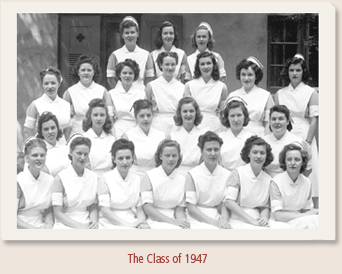
During the mid-1970s, Carey also helped
develop the educational component for the nurse-midwifery service
at Grady Memorial Hospital and helped integrate Emory midwifery
students into the Grady service, which had been established by Emory
faculty member Dr. Elizabeth Sharp several years earlier.
In the process, Carey and other faculty
worked to incorporate more intense science and clinical work into
the Emory graduate nursing program to meet the requirements of its
nurse-midwifery major. Ultimately, in 1976, the School of Nursing
received funding for the nurse-midwifery major and another grant
for some faculty positions to support it.
In 1980, Carey postponed her doctoral
work in educational leadership to work with Dr. Mary Hall in developing
two new graduate majors in nursing administration and teaching.
During the same time, Carey broke new ground as the first School
of Nursing faculty member to hold a dual appointment in teaching
and research. Working with Katherine Pope, the director of nursing
at Crawford Long Hospital, Carey explored staffing strategies and
conducted time and motion studies on units, noting how and where
nurses spent their time. As Carey notes, “Crawford Long was
able to get some new full-time positions on the units [because our
studies showed] the nurses spent too much time running up and down
the halls” as long as a city block.
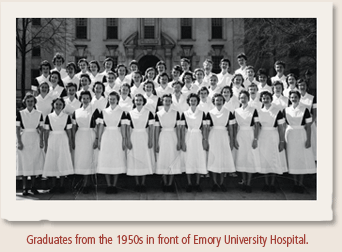
Looking ahead, Carey hopes the School
of Nursing will continue to move into the mainstream of the university
and broaden its worldview. “You don’t do that by cloistering
in a building all by yourself,” she says. “I think my
career reflects outreach, with helping develop dual-degree programs
in nursing and business [now ended] and nursing and public health.”
Under her guidance, students began
taking electives outside the school with other graduate students
in theology, law, business, and public health. “Mary Hall
and I tried in our nursing administration curriculum to break out
of the narrow nursing focus to gain a more worldwide view of the
health care system,” Carey says.
“I think that is our legacy.”
Mental
Health Pioneer
 ometimes,
you ometimes,
you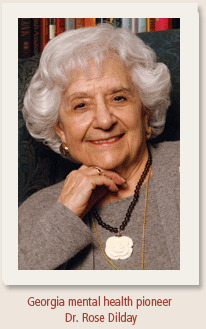 have to go backward to move forward. After graduating in 1937 from
Teachers College at Columbia University, Rose Dilday bought a gray
Plymouth coupe and drove it to Long Island to work as a public health
nurse. Problem was, her first day on the job, she didn’t know
how to drive in reverse. “The district supervising nurse had
to teach me,” recalls Dilday, who retired as professor of
nursing at Emory in 1979. Now, at age 90, she can look back on a
long career spent helping move things forward, particularly in psychiatric
and mental health nursing.
have to go backward to move forward. After graduating in 1937 from
Teachers College at Columbia University, Rose Dilday bought a gray
Plymouth coupe and drove it to Long Island to work as a public health
nurse. Problem was, her first day on the job, she didn’t know
how to drive in reverse. “The district supervising nurse had
to teach me,” recalls Dilday, who retired as professor of
nursing at Emory in 1979. Now, at age 90, she can look back on a
long career spent helping move things forward, particularly in psychiatric
and mental health nursing.
In 1952, while working as the public
health nursing supervisor for three New York townships, Dilday met
a state mental health nurse consultant and was impressed. Instead
of lecturing to expectant mothers and their families, the consultant
guided them through a process to help them understand and resolve
their problems. Intrigued, Dilday earned a master’s degree
in psychiatric-mental health nursing consultation (her first degree
was a BSN in nursing education) and joined New York state’s
Department of Mental Hygiene.
“My first assignment was to
integrate mental health concepts into maternal-child health services,”
explains Dilday. “My particular assignment was to train nurses
in this new approach to expectant parent education.”
Dilday enjoyed teaching other nurses.
She consulted in her own district and throughout the state and also
networked with mental health and psychiatry experts around the country.
Those experts came to know Dilday. During the early 1960s, the Kennedy
Administration awarded a mental-health planning grant to Georgia,
which needed a nurse on its planning team. A colleague recommended
Dilday, who joined the Georgia Mental Health Plan team in 1964.
A year later, Emory launched a new graduate program in psychiatric-mental
health nursing (the first such graduate program in the state). Dilday
served as
an adjunct faculty member for the program and touted its value throughout
the state. She was part of an interdisciplinary initiative to decentralize
the state mental health hospital in Milledgeville and understood
how important master’s-prepared psychiatric nurses were in
providing services in the community.
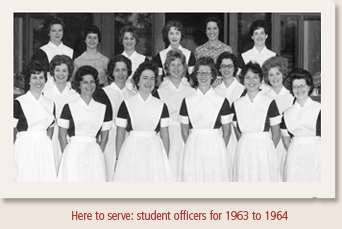
“The goal was to get patients
out of warehousing, get them near their families and get the community
mental health people to accept responsibility for them,” she
says.
Dilday joined Emory’s nursing
faculty full-time in 1968 when she accepted an offer from Dean Ada
Fort to direct Emory’s graduate program in mental health nursing.
In her new role, Dilday maintained
a strong relationship with the state and with the Department of
Psychiatry in Emory’s medical school. She brought in national
experts, including psychiatric nursing pioneer Hildegard Peplau,
to lecture to students. She chaired the psychiatric-mental health
program for undergraduate and graduate students (supported by “excellent
faculty,” emphasizes Dilday) and coordinated a number of first-time
courses. She introduced the nursing seminar to teach small groups
of undergraduates. And she was the first faculty member to place
graduate nursing students in community health centers for clinical
experience. In addition, Dilday secured more than $2 million in
training grants from the National Institute of Mental Health. Later,
she coordinated courses in continuing education, chaired national
symposia, and developed an impaired nurse program, among the first
in the country.
Through it all, Dilday often looked
backward to move ahead. “The thrill of education for me was
to be able to envision the end product. You start with the question,
‘How do you get a person to function a certain way, or what
does that person need?’ and then work backward from there.”
 |
The Associates' Personal Touch
Mary
Arnold and Neenah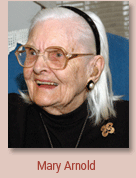 James have never met, yet their lives are forever linked.
James have never met, yet their lives are forever linked.
Arnold, 99, of Thomaston, Georgia,
is the oldest member of the Associates, a group of dedicated
women who support the School of Nursing. James, a former rock
singer, is a nursing senior aided by an Associates scholarship.
“I’m more like a fifth- or sixth-career student,”
James says. “I started out wanting to be an orthodontist.”
Like other Associates, Arnold
has a deep appreciation for nursing. She owes her life to
the two nurses who cared for her when she had typhoid fever
as a young child. Years later, Arnold came to know Emory through
its patient care and by joining the Associates. “I was
entranced by the nurses who spoke about their lives,”
she says.
The Associates were born in
1959 following a visit to Emory by Mary Clark Rockefeller,
who advocated that women become involved in university programs.
The group began with a core of 12 women, including Nell Hodgson
Woodruff; her niece, Nell Woodruff Hodgson Watt (“Little
Nell”); and Ellen Bowden, wife
of Emory alumnus Henry Bowden, then chair of Emory’s
Board of Trustees.
Today, the group funds annual
scholarships and takes time to hand out treats to students
on Halloween and Valentine’s Day. (Those duties belong
to the committee known as APT—Associates Personal Touch.)
They also present a Silver Bowl Award to an outstanding master’s
degree student at graduation. Currently, 80 members serve
the group, including Eleanor Richardson, former state representative;
Elizabeth Harris, former first lady of Georgia; and Berta
Laney, former first lady of Emory.
James was among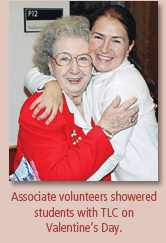 the
more than 200 students who stopped by the Associates’
goody table on Valentine’s Day. After graduating in
May, she plans to work in critical care nursing and eventually
the
more than 200 students who stopped by the Associates’
goody table on Valentine’s Day. After graduating in
May, she plans to work in critical care nursing and eventually
volunteer to care for underserved populations in the United
States and abroad. “I wanted to put my efforts into
something that actually made a difference and did some good
at the end of the day,” says James of her career choice.
“I wanted to make someone else’s life a little
better.”
|
 |
Full
Circle
 taying
home taying
home 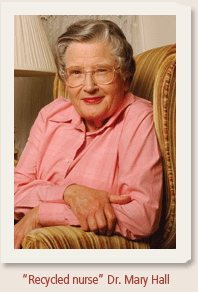 didn’t
last long for Dr. Mary Hall, 49N, 62MN, 83PhD, who retired in 1990
after a career teaching public health nursing and administration
at Emory. “I just had to get back to my nursing,” says
Hall, 77. didn’t
last long for Dr. Mary Hall, 49N, 62MN, 83PhD, who retired in 1990
after a career teaching public health nursing and administration
at Emory. “I just had to get back to my nursing,” says
Hall, 77.
So she took a job coordinating the
Children First Program for the College Park/East Point region of
the Fulton County Health Department. One or two days a week, she
visits high-risk infants in their homes and teaches mothers and
families how best to care for them. “The far-reaching impact
you can have as a public health nurse has always been my motivation,”
she says. “I’ve just recycled myself.”
Teaching is the thread that runs throughout
her career. When she visits the homes of young mothers, she arrives
to assess the baby’s health but ends up teaching each family
member
by example.
“Telling and preaching don’t
work,” she says. “Bedside manner and communication skills
are crucial in nursing. We are caring for our patients, whether
it’s in a hospital or in their homes, not dictating to them.”
Hall has learned these lessons through
experience. Her personal turning point hinged on the words of Julia
Miller, dean of Emory’s School of Nursing, in 1945. Hall was
an undergraduate
at the Georgia State College for Women in Milledgeville, where Miller
visited to discuss careers in nursing. “She sold me on the
School of Nursing at Emory and the idea of the baccalaureate nursing
degree. Otherwise, I might have simply attended [a diploma program]
and become a nurse that way.”
Eventually, Hall earned not only a
BSN degree at Emory but also a master’s degree in public health
nursing. When the School of Nursing received a grant to expand the
public health nursing curriculum, she was hired to the faculty.
The grant also helped start the Emory
Community Nursing Service. Former Dean Ada Fort was the impetus
behind the program, which provided nurses to manage chronic illness
in the home. Unpopular with local physicians at first, the program
paved the way for a new breed of independent, highly skilled nurses
trained to take charge and provide excellent care. It went hand
in hand with the concept of the family nurse practitioner, then
a revolutionary idea.
“Ada was visionary about that,”
says Hall. When Fort retired as dean, the program ended, but it
was too late to stem the tide. Family nurse practitioners were becoming
commonplace and more widely accepted. In 1974, Hall wrote a grant
that later evolved into the graduate-level family nurse practitioner
specialty.
“There was great discussion,
even among the nursing faculty, about the fact that the program
followed a medical model,” she says. “Nurse practitioners
require an in-depth background knowledge of disease, which nurses
had not focused on in the past. But we had the backup of some key
medical school faculty. They gave our medical lectures, and everyone
soon recognized
our value.”
In 1978, Hall received a grant to
fund several community-based clinics, including Johnson Ferry East,
a low-income public housing project in DeKalb County. These facilities
served as practice centers for public health nursing students and
faculty.
In 1983, Hall completed her doctorate.
(Her major interest was health policy and its evaluation.) A year
later, she was named interim dean, a role she held for almost two
years.
By the time she retired, Hall had
become a full professor and served as chair of the Division of Community
Health Nursing. Her current position with Fulton County is “Public
Health Nurse II,” a title not nearly as grand as “interim
dean” or “professor.” But she remains just as
proud of her current role nonetheless. “When former students
have supervised me in this program, I am so pleased,” she
says. “They’ve shown me I did my job well as a teacher.”
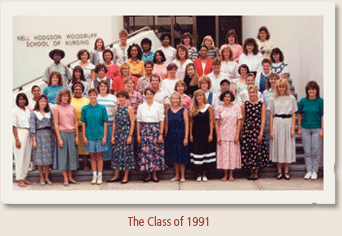
Early
Intrigue
 r. Jane
r. Jane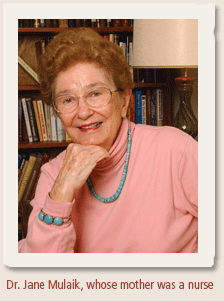 Mulaik came to nursing through both nature and nurture, thanks to
her mother, who worked as a nurse at a Louisville hospital during
World War II. Mulaik, who retired as an Emory nursing professor
in 1995, was in high school when she observed her mother on the
job. “She was an evening supervisor and covered the entire
hospital,” Mulaik recalls, “so I trotted along with
her to see what she did. Watching her work with patients really
had me intrigued.”
Mulaik came to nursing through both nature and nurture, thanks to
her mother, who worked as a nurse at a Louisville hospital during
World War II. Mulaik, who retired as an Emory nursing professor
in 1995, was in high school when she observed her mother on the
job. “She was an evening supervisor and covered the entire
hospital,” Mulaik recalls, “so I trotted along with
her to see what she did. Watching her work with patients really
had me intrigued.”
Also fascinated by chemistry, Mulaik
took time off from college to work at a DuPont laboratory. “I
discovered that to do anything in chemistry, you had to have a PhD,”
she says. “I thought, ‘Well, a PhD—not me.’
” Little did she know she would eat those words one day.
Mulaik did earn a bachelor’s
degree in chemistry and a master’s degree in psychiatric-mental
health nursing and initially taught nursing at the University of
Utah, where she got her first taste for research by collaborating
on a nursing performance study.
After joining Emory’s nursing
faculty to teach mental health in 1970, Mulaik eventually taught
students enrolled in the new RN to BSN program. Developed by Rose
Dilday, Jean Megenity, Bette McNeely, and other faculty in the 1980s,
the program—somewhat controversial at the time—enabled
nurses with a diploma or an associate degree to earn a baccalaureate
degree. Other changes followed.
In the 1980s, when the nursing school,
like the rest of the university, began to emphasize research, Mulaik
completed her PhD and joined with other faculty to create a research
culture.
“We started with a group of
people to do research on touch,” Mulaik says. This area of
study originated with Megenity, an Emory professor in maternal-child
nursing, and involved faculty from Emory and Georgia State Univer-sity
and students from Emory.
“We did a study of nurses’
response to touch, how they felt about it, and how they thought
patients responded,” Mulaik explains, “and then we did
a second study of patients and how they felt about nurses’
touch.” Mulaik also collaborated on a study on medication
compliance in psychiatric patients. “We found that patients
were less disturbed about side effects than they were about feeling
different from everybody else. They wanted to be out in the community
and society, and they felt the medications in part said they were
ill and not like those around them.”
Even with the demands of research,
faculty and student relationships in—and outside—the
classroom never faltered. Mulaik participated in the Nurse Today
Band, a group of faculty and students brave enough to play instruments
they hadn’t touched in years. And she and colleague Dr. Maggie
Gilead once beat the pants off their students in a lively round
of Trivial Pursuit.
As a nursing school veteran, Mulaik
has seen the school evolve considerably, with today’s student
body more diverse in age, race, and gender. Most students live away
from campus, which wasn’t always the case. “They have
separate lives from the nursing school, and so they are devoted
to their other lives as well as to nursing,” says Mulaik.
“So it’s not as easy to bring people together.”
Through all of its changes, Mulaik
believes the School of Nursing has contributed to the university’s
legacy in important ways. Ultimately, it has shown “that nurses
are bright, educated, and courageous people who have something to
offer.”
| |
Fireside
Companions
Students who attended the Wesley Memorial Training
School for Nurses beginning in 1905 often had company in their
dormitory rooms on cold winter nights. Their unlikely companions
didn’t raise even one disapproving eyebrow or shriek
of protest.
who attended the Wesley Memorial Training
School for Nurses beginning in 1905 often had company in their
dormitory rooms on cold winter nights. Their unlikely companions
didn’t raise even one disapproving eyebrow or shriek
of protest.
“The student nurses brought up buckets of coal from
the basement of their residence for the fireplace,”
explains Edith Honeycutt, 39N, 04H, who is a fountain of wealth
when it comes to School of Nursing history. “It was
the only heat they had after a long day’s work and allowed
them to sit by the warmth of the fireplace while they studied
in their rooms. The very large rats were definitely not pets
but often tried to share the warmth.”
Today, the School of Nursing has only one rat in residence.
The toy
replica, which belongs to Dean Marla Salmon, sits on the fireplace
hearth
in the main board room in honor of its real forebears at Wesley
Memorial.
—Pam Auchmutey
|
|
A
Living Legend
 t age 79,
t age 79,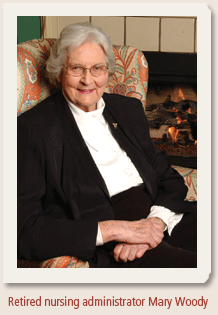 Mary Woody remains a striking figure in more ways than one. Just
over
Mary Woody remains a striking figure in more ways than one. Just
over
6 feet tall, silver haired, and plain-
spoken, Woody has been an innovative leader in nursing administration
and education for more than 40 years. Her concern for patients,
students, colleagues, and community evolved from her early experiences
in nursing and
her family ties to Lafayette, Alabama, where she grew up on a farm
and her father ran a gristmill and store.
“I never did really work on
the farm, but I always helped in the store,” recalls Woody,
the youngest of six children. “One time we decided to pick
some cotton, so my mother made us some cotton sacks. I think we
lasted about 30 minutes.”
Except for picking cotton, Woody has
never shied away from hard work. Fresh out of high school, Woody
took her first train trip to New Orleans to earn a diploma in nursing
at Charity Hospital. After graduating in 1947, she held a variety
of nursing positions—caring for her mother following cataract
surgery, testing Alabama residents for syphilis, working long shifts
at the hospital in Lafayette, caring for polio patients at a hospital
in New York City, and serving as a staff nurse at the VA hospital
in Montgomery, Alabama.
As a young nursing student, Woody
“knew I could do more than we were ever allowed to do.”
That desire led her to complete her baccalaureate and master’s
degrees in nursing at Teachers College at Columbia University. Eventually,
Woody returned south again in 1956 to join Emory University Hospital,
serving as a nursing administrator for 13 years. Her leadership
led to major improvements in patient care, including patient education
and implementation of the revolutionary principle that all patients
admitted should have an RN responsible for their care.
In 1968, Woody was named director
of nursing at Grady Memorial Hospital, where she helped create innovative
programs, including a diabetes day care program using nurse practitioners,
a nurse-midwifery service, specialized nurse-run clinics, and a
patient education program. She also influenced coronary care and
intensive care nursing in the South. As nursing care became more
specialized, she was one of the first administrators to seek out
advanced practice nurses at Grady and later at Emory.
Woody took on another new challenge
in 1979 as founding dean of Auburn University’s School of
Nursing. During her five-year tenure, she developed a practice-oriented
baccalaureate program that quickly received national accreditation
and put the school on a firm foundation.
While serving as dean had its rewards,
it took Woody away from patient care, and when Emory Hospital sought
her as director of nursing, Woody returned to Atlanta in 1984. She
also served as associate dean of the School of Nursing. Together,
Woody and Dean Clair Martin established a collaborative model enabling
hospital nurses to teach students and nursing faculty to maintain
a clinical practice. “We both profited,” Woody says.
“Collaboration” has been
part of Woody’s nursing vocabulary from the beginning. “It’s
working together—nurses, doctors, therapists, families, chaplains—that
makes things work,” she adds. “You do it with your heart
and mind and soul.”
As a result, Woody established additional
roles for Emory Hospital nurses in transplantation medicine, pain,
and incontinence management. She also knew where the buck stopped.
“Mary always cuts through to
what is right,” said Eleanor Lambertsen, former nursing dean
at Teachers College, when Woody retired. “She doesn’t
have to think about the ‘ethical’ thing to do. She doesn’t
think about what ought to be done. She thinks about what is right
for the patient.”
Woody served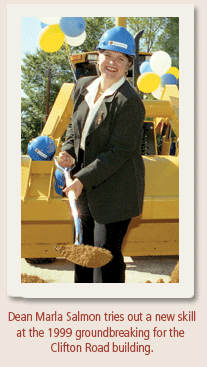 one year as interim dean of the School of Nursing before retiring
from Emory in 1993. She continued to receive accolades for her work.
In 1997, the American Academy of Nursing honored her with its Living
Legend Award, the profession’s highest honor. In 1999, she
received the Marie Hippensteel Lingeman Award for Excellence
one year as interim dean of the School of Nursing before retiring
from Emory in 1993. She continued to receive accolades for her work.
In 1997, the American Academy of Nursing honored her with its Living
Legend Award, the profession’s highest honor. In 1999, she
received the Marie Hippensteel Lingeman Award for Excellence
in Nursing Practice from Sigma Theta Tau International and was named
one of 50 “Women Pioneers in Health Care in Georgia”
by the state.
Woody continues to serve her profession.
She is a familiar sight at School of Nursing events and remains
active with the Associates, whose members provide scholarship support
for nursing students. It is one of many roles she has held for one
basic reason: “I love nursing and Emory.”
Pam
Auchmutey is editor of Emory Nursing magazine. Valerie Gregg is
a freelance writer and former editor of Public Health magazine.
| |
Labor
of Love
Hearing
Their Voices: Conversations with Retired Nell Hodgson Woodruff
School of Nursing Faculty” includes interviews with
14 faculty and alumni leaders. They are Dr. Shirley Carey,
82PhD; Ms. Rose Dilday; Ms.Betty Daniels, 51N, 67MN; Dr. Ada
Fort; Ms. Patsy Getz, 52N, 58MN; Dr. Mary Hall, 49N, 62MN,
83PhD; Ms. Edith Honeycutt, 39N, 04H; Dr. Elizabeth Mabry;
Ms. Harriet McDonald, 32N, 51N, 57MN; Dr. Jean Megenity; Dr.
Jane Mulaik; Ms. Barbara Reed, 57N, 79MN; Ms. Barbara Reich;
and Ms. Mary Woody.
Drs. Rose Cannon, Maggie Gilead,
and Sally Lehr conducted interviews for
the oral history project, funded by the School of Nursing,
from 2000 to 2004.
The interview with Fort, who died in 1998, was conducted by
Joan Raines in 1988. Megenity, whom Cannon interviewed in
2000, died in 2002.
|
|
|
 |











